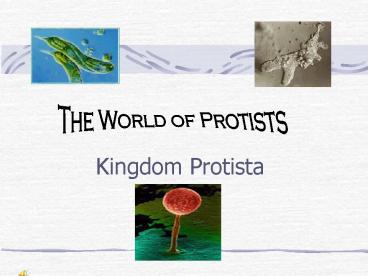Kingdom Protista PowerPoint PPT Presentation
1 / 42
Title: Kingdom Protista
1
The World of Protists
- Kingdom Protista
2
What Unites Kingdom Protista?
- All protists share the following
characteristics - They are eukaryotic and have membrane-bound
organelles.
3
What Unites Kingdom Protista?
- Protists are very diverse they differ in size,
shape and movement (locomotion).
4
Methods of Locomotion
- Pseudopods, which are extensions of the cytoplasm
are used by some protists like amoebas.
5
Amoebas in Action
6
Methods of Locomotion
- Flagella, which are whip-like structures, are
used by some protists like Euglena.
7
Methods of Locomotion
- Other protists, like paramecia, use cilia, which
are tightly packed rows of hair-like structures.
8
What Unites Kingdom Protista?
- Protists live in moist environments.
9
What Unites Kingdom Protista?
- Most are unicellular, but some are multicellular.
10
What Unites Kingdom Protista?
- Many reproduce asexually, but some can reproduce
sexually. - Sexual conjugation
- Asexual binary fission
11
What Unites Kingdom Protista?
- Many protists have mechanisms with which they
monitor their environments. - Some protists have an eyespot which they use to
sense light.
Chlamydomonas
12
Animal-like Protists Protozoans
- They are heterotrophic.
- Protozoans include 4 different phyla
- Flagellates
- Ciliates
- Sporozoans
- Amoebas
13
FLAGELLATES
- These protists swim using flagella
14
CILIATES
- Move using cilia
- When in fresh water, excess water moves into the
paramecium - They use contractile vacuoles to expel the excess
water.
15
(No Transcript)
16
SPOROZOANS
- These protists do not move on their own
- Parasitic
An electron micrograph of Plasmodium falciparum,
one of the parasites that causes malaria.
17
AMOEBAS
- Move using pseudopods (a false foot)
- Pseudopods are an extension of the cytoplasm that
stretches out, anchors itself and assists the
amoeba in moving.
18
(No Transcript)
19
Plant-like Protists Algae
- Algae are autotrophic and can carry out
photosynthesis. - Plant-like protists include
- Euglenoids
- Diatoms
- Dinoflagellates
- Algae
20
EUGLENOIDS
- Euglenoids are protists that move using flagella.
21
(No Transcript)
22
DIATOMS
- Diatoms are protists with glass-like shells made
of silica. - Many diatoms are used commercially in abrasive
cleaners, silver polishes and in the paint used
on roadways.
23
DINOFLAGELLATES
- Dinoflagellates are protists that have two
flagella - Several of these protists produce toxins which
can be poisonous - Commonly cause red tides
24
RED TIDES
25
ALGAE
- Algae are marine protists that can be red, brown
or green. - Many are eaten as food by marine life.
26
ALGAE
- Algae are useful commercially as well.
- Agar (recall from the bacteria lab) and
carageenan, an ingredient in ice cream are common
uses of algae.
27
ALGAE
- Other types of algae are sea lettuce, sea grapes,
kelp and seaweed, which is a common food product
in China.
28
Fungus-like Protists Molds
- Fungus-like protists are decomposers.
- These include
- Plasmodial slime molds
- Cellular slime molds
- Water molds
29
(No Transcript)
30
(No Transcript)
31
PLASMODIAL SLIME MOLD
- Slime molds are protists that consist of a slimy
mass of cytoplasm
32
CELLULAR SLIME MOLDS
- These protists are masses made up of individual
cells.
33
WATER MOLDS
- Water molds are fuzzy, white growths that feed on
decaying matter.
34
Diseases Caused by Protists
- Many protists are parasitic and can cause
diseases in humans other organisms such as - Malaria
- Amoebic dysentary
- Toxoplasmosis
- Sleeping sickness
35
MALARIA
- SYMPTOMS Fever, chills, confusion
- PROTIST Plasmodium
- MODE OF TRANSMISSION Mosquito bite
36
AMOEBIC DYSENTARY
- SYMPTOMS Bloody diarrhea
- PROTIST Entamoeba histolytica
- MODE OF TRANSMISSION Contaminated food and water
37
TOXOPLASMOSIS
- SYMPTOMS Brain damage death to fetus
- PROTIST Toxoplasma gondii
- MODE OF TRANSMISSION Contact with infected cats
38
SLEEPING SICKNESS
- SYMPTOMS Fever, weakness
- PROTIST Trypanosoma
- MODE OF TRANSMISSION Bite from an insect
39
Figure 1. Sarcodine diversity. (A) Amoeba, (B)
Radiolarian, and (C) Foraminifera
40
Figure 2. Ciliate diversity. (A) Structure of
Paramecium and (B) Vorticella
41
Figure 3. Diversity within the euglenoids and
green algae. (A) Euglena, (B) Chlamydomonas, and
(C) Volvox.
42
THE END
- Study for Quiz next class

